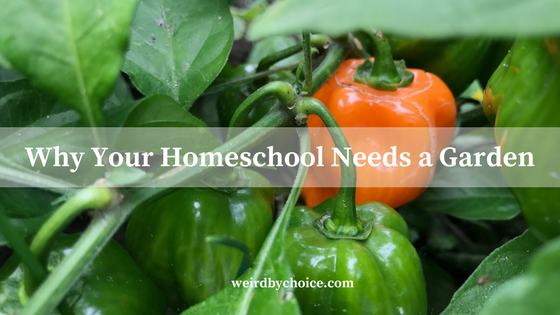After years of dreaming about having a garden, we finally dug in (literally!) and planted a beauty this year. Harvesting has begun, which got me thinking about what an amazing teaching opportunity it has been for the whole family.
Third-day creation lesson in living technicolor.
Despite the undeniable significance of Genesis 1, we can kind of gloss over it after awhile. Day and night. Yup. Heaven and Earth. Got it. Seas and land. Mmm hmmm. Mind starting to wander… But, growing your own garden, watching tiny green stalks blossom into massive producers of gloriously colored fruits and veggies, now that makes kids sit up and take notice. That’s tangible, in-your-face examples of God’s power and awesome creativity.
Science. Science. Science.
My kids LOVE whenever we talk about plants. Because unlike African mammals that they can only see online or from behind glass at the zoo, kids can interact with plants in a truly kinesthetic way, making the learning that much more engaging. While you’re planting you can talk about the parts of the plant and every time it rains or you go through periods of drought, you can tangibly reinforce what plants need to thrive. I was actually surprised to discover how a garden creates an amazing ecosystem to observe different animals as well. Worms, beetles and other insects, toads, snakes, birds, rabbits – they have all visited our garden this summer and my kids love to keep tabs! Kids love to get their hands dirty; you might as well make it productive.
Simple responsibilities.
There are so many simple ways that a child can help in the garden, which builds a sense of responsibility and a shared ownership in the project. Planting, weeding, watering, harvesting, or even just checking in on your plants every few days and reporting back observations are fun ways to involve the whole family.
A not-so-sneaky way to get your kids to eat more veggies.
Maybe your homeschoolers clean their plates at every meal and compliment mom’s cooking each night to “honor thy mother,” but if they’re like my kids, mealtimes are not very holy and varied veggies are not high on their list of favorites. I have two who eat carrots dipped in ranch, one who loves sweet peas, and lets see…well, are McDonalds fries even made from potatoes? Yeah, they need more veggies. I have found that everyone is at least willing to TRY the foods harvested from our garden because they have a vested interest in them.
Introductory cooking.
Most foods from the garden can be prepared and enjoyed in such simple ways that it’s a great way to introduce your kiddos to cooking. Let them help you snap beans, shuck corn, arrange veggie trays, etc. Older kids can be introduced to simple tasks like slicing cucumbers or tomatoes, how to use seasonings, or even steaming veggies.
Carry on a legacy.
In addition to eating lots of fresh fruits and vegetables, planting a garden usually means you’ll need to engage in some preserving. And there’s something about preserving that just screams old school, pioneer days type stuff. Whether it’s simple freezing or more involved practices like hot-water-bath canning, you have an opportunity to impart a sense of legacy with your kids through these simple activities. My nine-year-old daughter LOVED helping me can pickles. We made bread and butter like my husband’s grandma used to make and spicy dills like my mom and grandpa used to make. Traditions! Legacy! Memories! That’s time well spent.
We live on a city lot and managed to create a very productive garden in about 200 square feet. If you don’t have any green space to call your own, you could start with herbs on your windowsill or a few potted veggies on your patio. No matter the size, gardening is an awesome way to make science come alive. Dig in – you won’t be disappointed!





